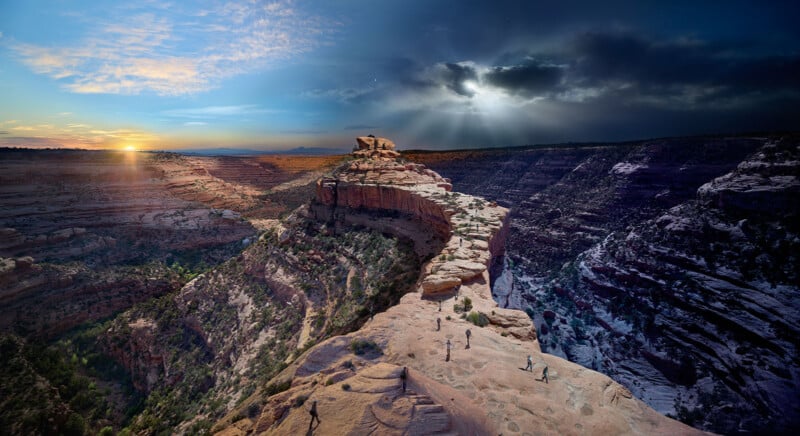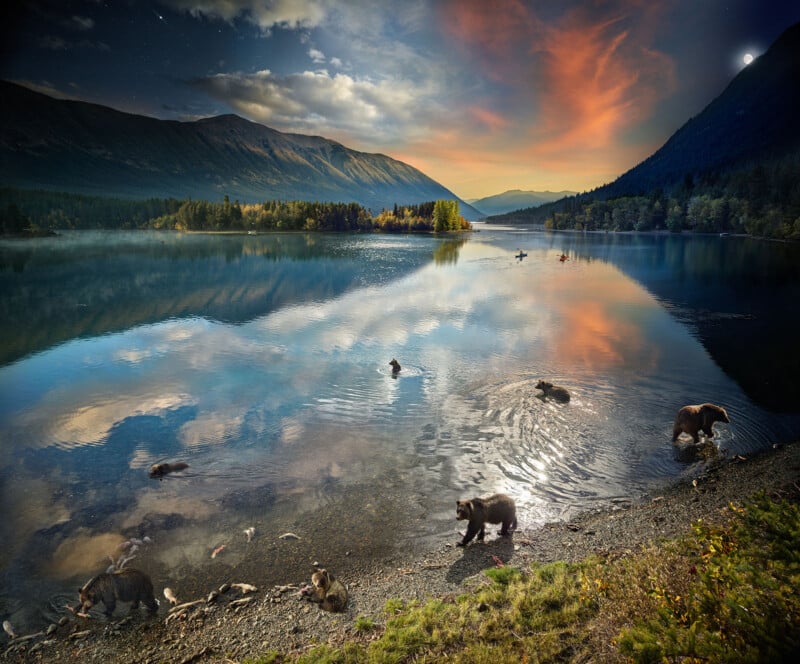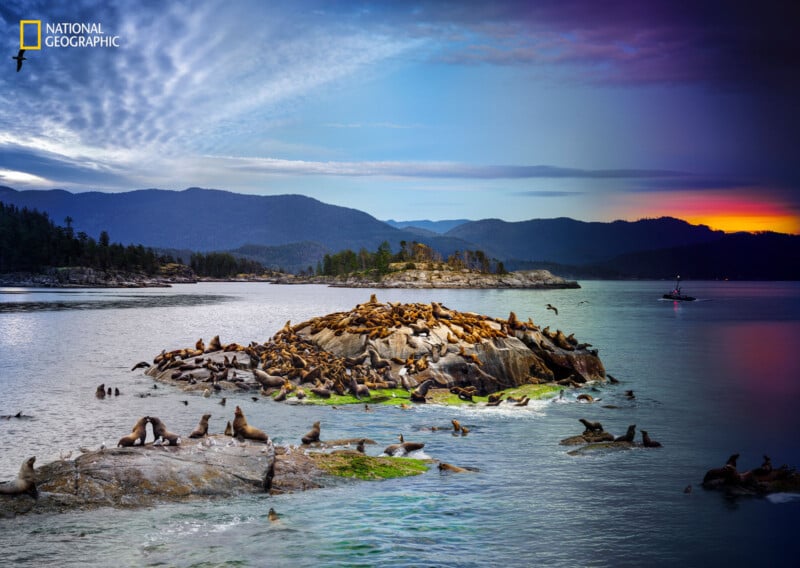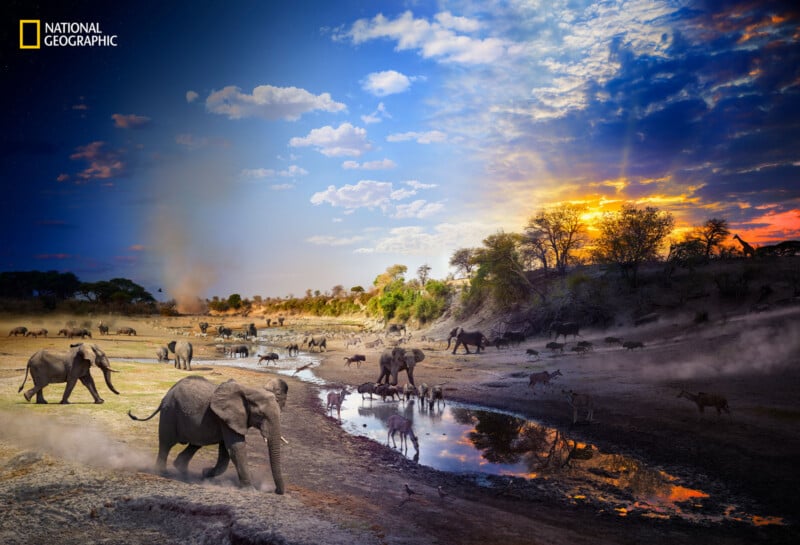How Stephen Wilkes’ Day to Night Photos Capture Wildlife In an Entirely Different Way
![]()
Award-winning photographer Stephen Wilkes has two photos in this year’s National Geographic Pictures of the Year, a celebration of 25 of the best and most important photos featured in this year’s issues of National Geographic. The photos, Wilkes’ famous Day to Night images, add a new layer — time — to beautiful wildlife scenes.
Wilkes’ two featured photos each show wildlife, albeit in very different ways and in vastly different climates. One features a Steller sea lion rookery in the Malaspina Strait in British Columbia, Canada, while the other shows a drought-ravaged water hole in Botswana’s Okavango Delta. The Steller sea lions, thanks in large part to significantly stronger protections from the Canadian government, are a recovering population. The antelope, hippos, elephants, and more in Botswana were struggling after a five-month drought, competing for every last drop of water, when they would have otherwise peacefully coexisted.
While Wilkes has long kept the secrets of his post-processing close to his vest, as part of Pictures of the Year 2025, the photographer has provided a never-before-seen look at how he and his talented team take his photos, captured over many hours, sometimes days, and create the final temporal composite.

“It’s always driven by narrative,” Wilkes says of the final decisions made about which precise moments to keep and which to leave out in the final photos. He says there are times when he is in the field, captures a shot, and just knows, “that has to be in the picture.”
And Wilkes is in the field a lot to create these photos. For the Steller sea lion shot, he was in a blind on a rock out on the water for nearly 50 hours, getting about “one hour” of sleep during the entire time. In Botswana, he was in a blind at the top of a jack mounted to a pickup truck, nearly 20 feet off the ground, for 18 hours, mostly in 105° F heat.
Not only does Wilkes need to be out there so long, constantly watching and shooting, to get the best final image, but he also argues that it’s essential to fully experience the ebb and flow of time in a space, to really get to know the animals and the place they call home.

A Stellar Photo of Steller Sea Lions
“It’s an amazing thing to witness over the course of time,” Wilkes tells PetaPixel of the Steller sea lions. “The males are the dominant species, and when they’re breeding, the whole idea is whoever is at the highest point physically on that rock becomes the dominant male. It’s like a game of king of the hill.”
Over the two days Wilkes was there, he witnessed males fight their way to the top, run out of energy, and then get bested again and again. After toppling the competition, the male stands as high as they can. These statuesque victors are seen throughout Wilkes’ photo. Each major rock area has its own king, albeit a temporary one.
Meanwhile, as the males are fighting over rocks, the females are often out hunting and gathering food for the young, who chase each other on the rocks and in the water.

All the while, as these different, interconnected relationships play out on what is ultimately a fairly small rock outcropping in the water, the tide is rising by a couple of feet per hour, which Wilkes describes as “dramatic.” It was also a challenge he had to overcome when shooting and creating the final shot: the action and sea lions were captured at all hours and at different tides, yet the final frame has a unified sea level, which is ultimately near its low tide position.
This challenge was “one of the things that was really exciting for me,” the photographer explains. “How do I manage capturing this, not only the transition of time and light and behavior, but also how do I show the dramatic changes this island takes over the course of 24 hours?”
Wilkes points out the green mossy area on the rock, which, when visible at low tide, “changed” the behavior of the sea lions.
“It was so rich and green and alive. It was spectacular. It was almost like a play land for the children,” Wilkes says, citing this experience as one of the standouts of his time in the field.
In the final shot, a group of pups chases each other through the scene, like a game of “follow the leader.”
“This is one of my favorite moments,” Wilkes says. “There’s this joyful celebratory aspect to these animals. When you study them for the course of 48 hours like I did, you begin to really see the individual personalities of these Steller sea lions.”
To ensure the sea lions felt safe and comfortable, Wilkes and his team carefully set up their blind so that a rock wall was behind it, facing the prevailing wind. This meant that the wind didn’t hit the blind and carry Wilkes’ scent toward the rookery rock. Sea lions rely heavily on their olfactory senses, so it made a huge difference that they couldn’t smell the photographer. He believes he is the first person to be allowed on these islands, at least since the Canadian government began protecting the Steller sea lion habitat, so it was essential to make as small an impact on the environment and animals as possible.
‘When you study them for the course of 48 hours like I did, you begin to really see the individual personalities of these Steller sea lions’
Nonetheless, Wilkes recalls one specific sea lion who seemed especially interested in what was going on in Wilkes’ temporary home.
“He was very curious about me,” Wilkes laughs. “He couldn’t really identify me or smell me, but he was curious.”
Wilkes emphasizes that he is not a timelapse photographer. Not that he knocks the craft by any stretch, but he says it implies a sort of automation of the photographic process. Instead, he intentionally captures every single shot.
“I’m reacting to what I’m seeing — take a picture. Every moment that you see is something that I’m actually focusing on at a given moment in time. My eye basically moves from left to as time changes,” Wilkes says. “So in the morning, my eye was focused early in the morning on this relationship, these things that were happening here, things that were happening in the foreground, all of that was part of my focus. As time changes, my focus begins to change. I move my eye towards what I call the vector of time.”
He likens his process to those he has used throughout his career as a documentary and sports photographer. While his Day to Night project, started in 2009, is arguably his most famous, he has been a professional photographer since 1983, earning acclaim for fine art, editorial, and commercial work.
‘Every moment that you see is something that I’m actually focusing on at a given moment in time. My eye basically moves from left to right as time changes’
One thing that has been common throughout his career, albeit manifested differently for Day to Night, is Wilkes’ deep obsession with his craft and subjects. Wilkes calls focusing on a single scene for two straight days a meditative experience.
“[It’s] a physical visual meditation of me staring at a place over the course of 24 to 48 hours [and] gives my work a certain depth,” Wilkes says. “And also you can see the moments I’m capturing are, in a way, they’re kind of magical… I think what I try to do is I’m trying to communicate the visual language that these animals and these wildlife were sharing with me. I’m becoming a part of that language in a way, and that’s what I’m trying to share. It’s been a really enlightening experience being able to do these pictures.”
Successfully achieving that feat does not come easily. Wilkes believes much of his success relies on the energy he brings and puts out into the world.
“What I project into the scene, that’s something a lot of people don’t really understand or talk about enough, the way you are and what you put out in terms of your energy,” Wilkes says. “If you create fear — you hear stories about this all time, animals have a certain instinct to smell fear and having that kind of energy, when you project that, the animals sense that.”
‘It’s been a really enlightening experience being able to do these pictures’
In contrast, Wilkes tries to always be positive and respectful, which he believes the animals can sense, and this makes them feel more comfortable with his presence.
“It’s a great gift to be able to witness” the animals going about their lives, the photographer remarks. Wilkes thinks that being out in the field for so long, focused on his work and nothing else, is a privilege. It’s a challenge, too, of course.
“It’s an unbelievably powerful way to reconnect to the world and be present. I think that’s one of the great joys of being able to migrate [Day to Night] to shooting wildlife. I feel like, in a way, it’s given my work a deeper purpose,” Wilkes says. “I think once you create art with purpose, it’s very hard to create art that doesn’t have purpose. This is what I love to do.”
A Very Different Energy in Botswana
When Wilkes photographed a different watering hole in Serengeti National Park in Tanzania, he witnessed a vastly different scene than he did in Botswana in the Okavango Delta.
“They feed together, they stay together,” Wilkes says of many of the African wildlife, particularly the ones that are often prey for apex predators like lions. “They stay together [because] the likelihood you’ll both be attacked by a predator goes down substantially. That’s what I witnessed when I photographed my Serengeti image over the course of 26 hours.”
“But here I was photographing for 18 hours,” Wilkes says of Botswana. “And it was not a five-week drought like it was during the Serengeti photograph it was now a five-month drought. What I witnessed here was that the animals have changed their behavior. They’re not sharing water anymore, it’s totally abut survival of the fittest. The scarcity I witnessed firsthand, a sort of uncontrollable chaos over the course of the 18 hours I photographed and watched [was different].”

Wilkes points to different areas of the photograph that capture this new animosity and tension at the watering hole. Wildebeests are being terrorized by an elephant in one area, while another shows a hippo staring down an elephant, nearly daring it to come any closer.
“That was a moment I’ll never forget. I could feel this hippo look at a young elephant and say, ‘Don’t even think about drinking my water.’ You could feel his energy,” Wilkes says. “I realized that the water had changed the entire vibe, the dynamic. The chaos I was watching was all about water.”
Or really, the lack of water. These animals need to drink, and their food requires water to survive and grow. As Wilkes says, nature is so often about balance, and when the balance shifts or gets out of whack, like during a drought, everything changes.
At one point early in his day in Botswana, positioned in an elevated blind 15 to 20 feet in the air, a young elephant took notice of Wilkes and the truck.
‘The chaos I was watching was all about water’
“He’s staring me down,” Wilkes says. “These animals are so smart, they have so much energy. The way they project, when they look at you and lock eyes, you know you’re in the presence of a high intelligence.”
That’s part of what makes elephants so special, but it’s also part of what makes them potentially dangerous. This elephant was fixated on Wilkes and postured aggressively for about 45 minutes. Wilkes says the guide, who was in the truck itself, was convinced the elephant was going to charge. He was showing all the signs.
“My assistant and I were basically hyperventilating. We’re so scared, but we’re trying to show love and calmness and everything,” Wilkes says, able to chuckle about the event now. If the elephant had charged, it would have spelled trouble. The truck, which was partially jacked up to support the elevated blind, was unable to escape. The elephant, while young, had plenty of size and strength to topple the entire thing over.
Ultimately, a much older, massive female elephant came through and trumpeted louder than Wilkes had ever heard before, and rammed the young elephant. After that moment, no other elephant hardly looked at Wilkes.
“This male just walked away, and nobody came near me the rest of the day,” Wilkes says. It felt like somebody was looking down on me because the thought of being charged when you’re up in a truck 15 feet in the air is not a very reassuring feeling.”
‘My assistant and I were basically hyperventilating. We’re so scared, but we’re trying to show love and calmness and everything.’
“But it was all worth the effort to make this picture,” Wilkes says. “Sometimes the natural world helps you out. I was very lucky.”
The animals in the picture, which include 10 different species, were unfortunately not so lucky, all struggling to survive through a particularly horrible drought.
“This picture is canary in the coal mind,” he says, alluding to how a changing climate and inadequate resource management have far-reaching impacts. While the rebounding Stellar sea lions in British Columbia serve as a positive indicator species, showing that environmental protections are working and the habitat is improving, returning to a natural balance, the drought in Botswana reflects what can happen when nature is out of balance.
Wilkes rightly believes that he has a responsibility to bring these important stories to a broader audience. Photography is a powerful tool for effecting change, and Wilkes’ images are an especially robust means of visual storytelling. They quite literally tell the story of a day or more in a single frame, condensing all these moments and interactions into one shot.
“That’s how you begin to move the needle, through inspiring. Sometimes it’s one person at a time, but you just got to keep doing it,” Wilkes says.
“There’s this power of the individual that we can all make a difference by just doing something,” Wilkes continues, citing the late, great Jane Goodall. “And once you learn how to do one thing, you realize it wasn’t that hard. And you can do something else. Suddenly, it grows. That’s how we forge change. And I think that’s what must happen here, we have to collectively recognize what’s happening globally with our climate and figure out how to protect species.”
Wilkes, a grandfather now, wants to be able to take his grandchildren to see the places he’s photographed, and he desperately hopes the environments are healthier than they are today.
“I don’t want the only history of wildlife they see to be these photographs,” Wilkes says.
Image credits: Stephen Wilkes. National Geographic Pictures of the Year 2025.